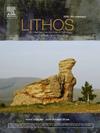Late Triassic ultrahigh-temperature mafic granulite from the North Dabie terrane, Central China
IF 2.5
2区 地球科学
Q2 GEOCHEMISTRY & GEOPHYSICS
引用次数: 0
Abstract
Ultrahigh-temperature (UHT) granulites, essential components of collisional orogens, preserve key records of orogenic geodynamics. This investigation provides a systematic examination of mafic granulites from the Dabie orogenic belt through integrated petrological and geochronological analyses. Petrographic observations and phase equilibria modeling reveal clockwise pressure-temperature (P–T) paths, involving an inferred middle-pressure (MP) high amphibolite–granulite-facies (M1; 10.7–11.7 kbar and 745–810 °C) followed by decompressional heating, UHT granulite-facies metamorphism (M2; 6.5–6.8 kbar and 938–950 °C) and subsequent cooling, amphibolite-facies stage (M3; 3.6–4.5 kbar and 636–660 °C). In-situ zircon dating show that the granulite has a protolith age of ∼1805 Ma and underwent HP and UHT metamorphism during the Late Triassic (∼215–197 Ma; M1–M2), followed by amphibolite-facies retrograde metamorphism from 193 to 172 Ma (M3). Meanwhile, zircons within the granulites document anatexis at ∼120 Ma, corresponding to orogenic collapse of the Dabie orogenic belt. We propose a metamorphic process of the mafic granulite as follows: the ∼1.8 Ga mafic rock was buried to the MP amphibolite-granulite-facies level during the Triassic continental collision orogenesis, and was heated by the upwelling asthenosphere during exhumation, leading to UHT metamorphism; and subsequently, it was chilled and retrograded to amphibolite-facies level. This study establishes critical constraints on syn-collisional thermal-tectonic coupling in continental collision zones, with deep thermal processes recorded by mafic granulites enhancing our understanding of the spatiotemporal evolution of orogenic events in both ancient and active mountain belts globally.
中国中部大别地块北部晚三叠世超高温基性麻粒岩
超高温麻粒岩是碰撞造山带的重要组成部分,保存着造山带地球动力学的重要记录。通过岩石学和年代学的综合分析,对大别造山带基性麻粒岩进行了系统的研究。岩石学观察和相平衡模拟揭示了顺时针的压力-温度(P-T)路径,包括推断的中压(MP)高角闪岩-麻粒岩相(M1;10.7 ~ 11.7 kbar, 745 ~ 810℃),其次是减压加热,UHT麻粒岩相变质作用(M2;6.5-6.8 kbar, 938-950°C),随后冷却,角闪岩相阶段(M3;3.6-4.5 kbar, 636-660°C)。原位锆石测年表明麻粒岩的原岩年龄为~ 1805 Ma,在晚三叠世(~ 215-197 Ma)经历了高温和超高温变质作用;M3),其次为角闪岩相逆行变质作用(193 ~ 172 Ma)。同时,麻粒岩中的锆石记录了~ 120 Ma的深熔作用,对应于大别造山带的造山崩塌。我们认为基性麻粒岩的变质过程如下:~ 1.8 Ga基性岩在三叠纪大陆碰撞造山过程中被埋藏至MP角闪岩-麻粒岩相水平,在挖掘过程中被上升流软流圈加热,导致UHT变质;随后,储层被冷却并退行至角闪岩相层位。通过基性麻粒岩记录的深部热过程,建立了大陆碰撞带同步碰撞热—构造耦合的临界约束条件,增强了我们对全球古山带和活动山带造山事件时空演化的认识。
本文章由计算机程序翻译,如有差异,请以英文原文为准。
求助全文
约1分钟内获得全文
求助全文
来源期刊

Lithos
地学-地球化学与地球物理
CiteScore
6.80
自引率
11.40%
发文量
286
审稿时长
3.5 months
期刊介绍:
Lithos publishes original research papers on the petrology, geochemistry and petrogenesis of igneous and metamorphic rocks. Papers on mineralogy/mineral physics related to petrology and petrogenetic problems are also welcomed.
 求助内容:
求助内容: 应助结果提醒方式:
应助结果提醒方式:


